St. Philomena’s College, now in its Platinum Jubilee Year, 2020-2021 will be a landmark year in more ways than one. Along with educational institutions the world over, the college must now navigate the unprecedented challenges of the COVID-19 pandemic. The scale of this clear and present danger calls for an acceleration of personal dedication and collective effort.
Dedication is the bedrock on which St. Philomena’s has been built and nurtured throughout its rich history of 75 years. Successive College Principals and Administrators have all played a role in making the institution what it is today and it is fitting that the present generation acknowledges their contributions.
1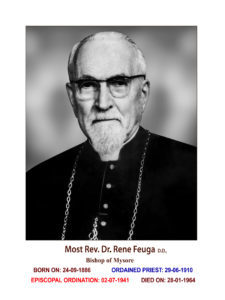
MOST REV. DR. RENE FEUGA – FOUNDER PATRON (1946-1964)
Bishop René-Jean-Baptiste-GermainFeuga, M.E.P., fondly known as Bishop Feuga was the first Bishop of the bifurcated Diocese of Mysore with its headquarters in Mysore and the founder Patron of St. Philomena’s College. He was consecrated Bishop in 1941 and continued as the first prelate of the present Mysore diocese till he retired in 1962. His term was extended as Bishop till his demise in 1964.
Missions Etrangeres de Paris (MEP) commonly known as Paris Foreign Mission Society started sending priests to India in the latter part of the 18th century. The Vicariate of Mysore, where they started working after the Jesuits, paved the way for the creation of the Diocese of Mysore with its headquarters in Bangalore in 1886. The MEP fathers started a number of educational institutions in Bangalore, including the famous St. Joseph’s College, St. Joseph’s European and Indian High Schools.
Rev. Fr. Rene Feuga, ordained priest at the young age of 24 in France, joined the MEP and came to India in 1913 and worked for a number of years in Bangalore, the headquarters of the then Mysore diocese. Among many posts he held, he chaired the French Department at St. Joseph’s College, Bangalore which was affiliated to Madras University. He was proficient in English, Kannada and Tamil besides his mother tongue French.
Later he came to Mysore and chaired the French Department in Maharaja’s College thus establishing his academic credentials in the University of Mysore. In 1929 he had the privilege of being appointed by the Philosopher – King His Highness Nalwadi Krishna Raja Wodeyar, preceptor to his nephew ChamarajendraWodeyar who succeeded him as the Maharaja of Mysore in 1940, ushering a close bond between Bishop Feuga and the Mysore royal family, which lasted till his demise in 1964 and continued with his successor bishops of Mysore.
After serving as the Parish Priest of St. Philomena’s church, from 1931 to 1941, which was later to become his cathedral, during which period he built the majestic gothic structure, he was appointed the first Bishop of Mysore with its headquarters in Mysore in 1941. Being at the helm of the new diocese, he knew, besides pastoral work he had to give fillip to education. He founded St. Philomena’s High School in 1942. The plans were already afoot to start an intermediate and Degree Science and Arts College in Mysore. Bishop Feuga readily vacated his newly constructed ‘Bishop’s Mansion’ (the present Administrative Block) choosing to reside in two small rooms at St. Philomena’s Cathedral, till the new Bishop’s House was built. His close friend, student and well-wisher Maharaja H. H. ChamarajendraWodeyar, matched his mentor’s sacrifice with a generous grant of 29 acres of land adjacent to the then Bishop’s Mansion and a matching grant for the non-recurring and recurring expenses of the new college. Thus ,was born on June 6, 1946, the iconic St. Philomena’s College, the dream child of Bishop Rene Feuga.
In founding and nurturing St. Philomena’s College during its fledgling years, Bishop Feuga was ably supported by the first principal, Rev. Fr. C.A. Browne, visionary procurator Rev. Msgr. Maurice Queguiner, Msgr. A. Cappelle not forgetting Rev. Fr. Audiau, who stalled the decision to hand over the college to the Jesuits, as it was done by MEP fathers in Bangalore, as the going was tough and financial liabilities mounting. He donned the mantle of its fourth Principal in 1952 and steered it smoothly till 1960 when he had to return to France for good.
To find the required funds for the college, Bishop Rene Feuga visited a number of places in Europe and America. He sought blessings from His Holiness Pope Pius XII, who not only blessed the College Project, but also wrote in his own hand on the picture of Bishop’s Mansion, which was to become the nucleus of the new college, a quotation from St. Paul’s letter to the Philippians “caritas vestramagis ac magisabundet in scientia” (may your love grow richer and richer in knowledge). Taking the first and the last letters of this quotation, Bishop Feuga chose the motto of the college “CARITAS IN SCIENTIA (Love through Knowledge).
Bishop Feuga provided all financial resources and personnel by appointing a number of MEP and diocesan priests to teach and manage the college and the boy’s hostel. Some were sent to Cambridge and Rome to study and five local priests were sent to St. Philomena’s college itself to complete Bachelor’s degrees, who after completing their Masters, taught in the college. One of them, Fr. N.T. Thomas became the first alumnus to become the Principal in 1960. As recorded by Rev. Fr. Browne, Bishop Feuga, after II World War, purchased an entire American army field hospital to equip the science labs.
As the college is on the threshold of its Platinum Jubilee, it fondly remembers and salutes its visionary and charismatic founder Patron Bishop Rene Feuga.
2. 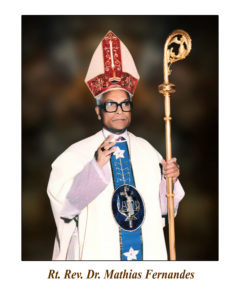
Most Rev. Dr. Mathias Fernandes (1964-1985)
Bishop Mathias Sebastião Francisco Fernandes commonly known as Bishop Mathias Fernandes was appointed the second Bishop of the present Diocese of Mysore and consecrated on February 3, 1964 at the young age of 46. Hailing from Goa, he chose to be a missionary in the large undivided diocese of Mysore. His relentless work, mostly in villages like Shettihalli and Nagavallil prompted him to uplift the poor from rural areas when he became the Bishop of Mysore. Using existing educational institutions and setting up many new ones, he helped hundreds of young people from rural areas to pursue higher studies and most of them became lecturers, high school teachers, doctors and engineers.
Bishop Mathias Fernandes took keen interest in the growth of St. Philomena’s College. Recognizing this ,the Government of Karnataka nominated him twice to the Senate of the University of Mysore. He maintained a very good rapport with Governors, Chief Ministers, academicians and other religious leaders.
Bishop Mathias Fernandes used to visit St. Philomena’s College regularly, address the students from time to time, and maintained a close contact with the staff. Any member of the staff could walk into Bishop’s office, even without prior appointment and found in him a guide and an adviser for all their problems, even personal ones.
It goes to the credit of Bishop Mathias Fernandes the infra-structural growth that was undertaken in the College campus. In 1966 a much-needed elegant auditorium was constructed and in 1981 the ground floor of the library block. It was during his tenure as Patron of the College, its Silver Jubilee was celebrated.
Bishop Fernandes was proud to be the Patron of St. Philomena’s College and till his untimely death in 1985 strove to maintain the premier place it held in Mysore city. A number of members of the staff and alumni remember Bishop Mathias Ferandes, as a humane pastor and administrator
3. 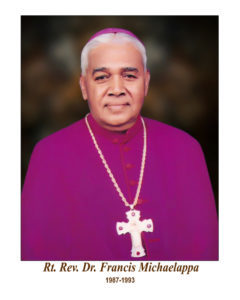
Most Rev. Dr. Francis Michaelappa (1987 – 95):
Rt. Rev. Dr. Francis Michaelappa, a priest of the Arch-diocese of Bangalore, hailing from Harobale was consecrated the third Bishop of Mysore on May 27, 1987.
Besides studies in Philosophy and Theology, Bishop Michaelappa had a Master’s Degree in Communication and Journalism from Marquette University, Milwaukee, Wisconsin, USA. He had vast knowledge of Kannada literature and quoted eloquently from the Vachanas in his speeches. Simple and humble, but extraordinarily human, Bishop Michaelappa was proud to be chairman of St. Philomena’s College, the most prestigious college in Mysore city. Though he had many health issues, he bravely managed the diocese of Mysore and its institutions, including St. Philomena’s. He died on March 17, 1993.
4. 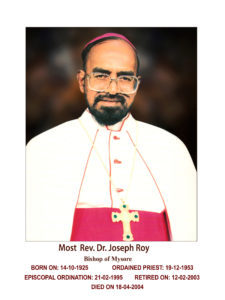
Most Rev. Dr. Joseph Roy (1995-2003):
Rt. Rev. Dr. Joseph Roy, born and brought up in Mysore, was the fourth Bishop of Mysore and the first local Bishop. He cherished the memory of having stayed during his minor seminary days in the 1940’s in the present Administrative Block of the college which was the Bishop’s Mansion and also the diocesan minor seminary, before it was handed over to the College.
As a Mysorean, he had seen the growth of St. Philomena’s College from its inception and was proud to be its chairman for eight years till he retired as the Bishop of Mysore in 2003.
Aware of the need to take risks to ensure the academic growth of the college, he encouraged the Principal of the College, Rev. Fr. Leslie Moras in every way and supported him in starting a number of new courses and developing the infra structure. It was during his time that the massive granite compound wall around the college campus was completed, three more floors were added to the library block and an elegant canteen nestling among trees was constructed. Thanks to his support and encouragement,new Computer Science, Micro-biology, Biochemistry and Bio-technology laboratories were set up in the college. A number of new courses and subjects were also introduced.
The grand celebration of the Golden Jubilee which was held under Bishop Roy’s leadership will be etched in the annals of St. Philomena’s College. A beautiful Octagonal Chapel constructed at the main entrance of the College in memory of Bishop Rene Feuga, the founder of the college and the statue of St. Philomena on a lofty pedestal in the middle of a beautiful fountain, with lush green lawn around it were the additions made to the college during the Golden Jubilee year with the support and encouragement of Bishop Joseph Roy.
Bishop Joseph Roy retired as the Bishop of Mysore in February 2003, but continued to be associated with it till his demise on April 18, 2004.
5. 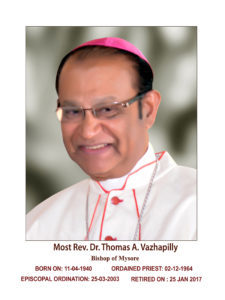
Most Rev. Dr. Thomas Anthony Vazhapilly (2003-2017):
Rt. Rev. Dr. Thomas Anthony Vazhapilly, the fifth Bishop of Mysore was not a stranger to Mysore or St. Philomena’s College. He used to visit this college from his boyhood to meet his uncle Rev. Fr. Thomas Vazhapilly who was the Head of the Department of Botany and later Principal of the College. It was his uncle who encouraged Rt. Rev. Dr. Thomas Anthony Vazhapilly join the diocese of Mysore. But just before his ordination in 1964, he had to opt for the Diocese of Chikmagalur newly carved out of the diocese of Mysore. But God’s plan brought him back as the fifth Bishop of Mysore on March 25, 2003.
Bishop Vazhapilly has been an academician for the most part of his life. He started as a teacher in St. Joseph’s High School in Chikmagalur. He was sent to Rome for higher studies where he completed his doctoral studies in Moral Theology from the Gregorian University. From 1980 to 2003, he was a Professor of Moral Theology at St. Peter’s Pontifical Institute, Bangalore and later became the President of the Institute and Rector before his election as the Bishop of Mysore.
His long association with the College, even though he was not in Mysore, made him evince keen interest in the growth of the College as soon as he took over the diocese of Mysore. Thanks to his support and encouragement to the Principal, Rev. Fr. Leslie Moras, the college saw exponential academic and infra-structural growth. Post Graduate courses were started the first time in 2008. Very soon, a massive post-graduate block with five floors was constructed in a phased way to house 13 post graduate courses and also a research centre. A number of distance education courses were initiated and two more floors were added to the Chapel block; a modern Ladies’ Hostel building with five floors to accommodate up to 350 students was constructed.
Bishop Vazhapilly encouraged the Principal and the staff to increase student strength both from within the country and abroad. Thanks to his support the college could boast of students from 33 countries including France, US, Canada and a number of African and Asian countries. The growing fame of the college also brought students from 19 different states of India.
It was during the chairmanship of Bishop Thomas Anthony Vazhapilly that the academic excellence of the college reached its peak. The college was accredited by NAAC in 2004 with A+ grade and in 2014 again with a CGPA of 3.58 on a four-point scale. The college was declared a College With Potential For Excellence in 2010, a College of Excellence in 2015 and an autonomous college in 2011. All these achievements also brought substantial grants from the UGC for the infra structural growth of the college. To meet the growing needs of the college and to encourage sports and other academic activities, an outdoor stadium and a beautiful massive multi-purpose indoor stadium which can accommodate up to 1500 students were constructed. The Indoor Stadium is a monumental addition to the college where, ever since its inauguration, hundreds of programmes of the college, UG, PG and PUC and most of the programmes of the diocese, MDES and many others are regularly held.
During the tenure of Bishop Thomas Antony Vazhapilly, hundreds of seminars and symposia have been conducted. Thanks to the close collaboration of BishopVazhapilly and the Principal, Fr. Leslie Moras, the Diamond Jubilee of St. Philomena’s College and a National Seminar on “Religion, Spirituality and Education in the challenging Globalized World’ were inaugurated by the then President of India His Excellency Dr. A.P.J. Abdul Kalam on April 8, 2007, The inaugural function was attended by over 5000 academicians, students, alumni and distinguished members of the public. Dr. A.P.J. Abdul Kalam was also the Chief guest for the Graduation Day in 2013.
Also thanks to the encouragement of Bishop Vazhapilly the first ever International Conference on “Climate Change – Inconvenient Truths, status and way forward” was held, paving way to two more International Conferences on UN Sustainable Development Goals in 2017 and 2019.
By the time Bishop Thomas Anthony Vazhapilly retired as Bishop of Mysore and Chairman of St. Philomena’s College (Autonomous) in January 2017 and his close collaborator Rev. Fr. Leslie Moras as Principal and as Rector a few months, St. Philomena’s College had reached a high-water mark in its history, leaving to their successors, the onus of sustaining this eminence and taking the college forward to greater heights.
